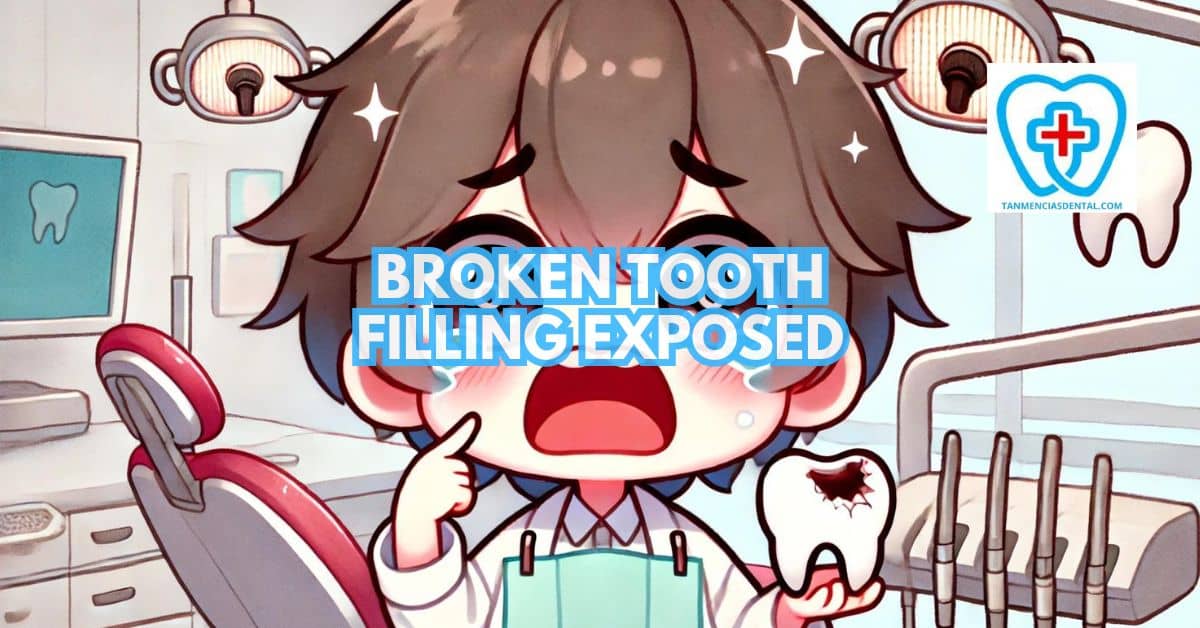A broken tooth filling occurs when the material used to repair a damaged tooth either cracks or becomes loose, exposing the inner layers of the tooth.
This can lead to sensitivity, pain, and a higher risk of infection.
Fillings are designed to withstand the forces of biting and chewing, but various factors can cause them to fail over time.
Understanding these causes is important to prevent long-term dental problems.
We’ll discuss the common reasons fillings break and expose the tooth, along with tips to prevent this from happening.
1. The Impact of Chewing Hard Foods on Tooth Fillings
Chewing hard foods like nuts, ice, and hard candies can place an enormous amount of pressure on tooth fillings.
This pressure can cause the filling material to crack or loosen, especially if it has already worn down over time.
Fillings are particularly vulnerable if the food is unexpectedly hard or if the bite force is uneven.
Avoiding these foods or being mindful while chewing can help protect the filling from damage.
Softer food choices and cutting hard foods into smaller pieces can significantly reduce the risk of a broken filling.
🦷 Reasons Why Dentists Are Happier Than You Think
2. How Teeth Grinding and Clenching Can Damage Fillings
Teeth grinding (bruxism) and clenching apply constant pressure to teeth, which can lead to the gradual weakening of fillings.
Over time, this repeated stress can cause fillings to crack, wear down, or even fall out.
Many people grind their teeth at night without realizing it, making the damage slow but cumulative.
Wearing a mouthguard during sleep or managing stress to reduce clenching during the day can protect the teeth and fillings from damage.
Without intervention, bruxism can cause both fillings and the natural teeth to deteriorate.
🦷 Understanding Broken Tooth Repair Cost: What You Need to Know Before Your Dentist Visit
3. Understanding Wear and Tear on Old Tooth Fillings
All fillings have a lifespan, and as they age, they become more susceptible to breaking.
The constant stress of chewing, along with temperature changes from food and drink, can slowly erode the filling.
Amalgam fillings, in particular, tend to expand and contract more significantly with heat, which can weaken the tooth structure over time.
Older fillings also have a greater chance of developing small cracks or gaps where bacteria can enter.
Regular dental exams allow the dentist to monitor the condition of old fillings and replace them before they fail completely.
🦷 Dental Hygiene for Kids: Sparkling Smiles and Happy Brushing Adventures Await!
4. How Decay Around Fillings Can Lead to Exposure
Tooth decay can form around the edges of a filling if plaque is not effectively removed from the area.
Over time, this decay weakens the surrounding tooth structure, making the filling less stable and more prone to breaking or becoming exposed.
When bacteria invade the space between the tooth and the filling, they can cause further damage, leading to larger cavities and exposing sensitive areas.
Proper oral hygiene, including brushing and flossing around the filling, is essential in preventing this decay from occurring.
Regular dental checkups allow early detection of decay, preventing more serious issues like filling exposure.
🦷 Understanding Dry Mouth After Brushing Teeth: Causes and Solutions
5. The Effects of Injury and Trauma on Tooth Fillings
Accidental injuries, such as falls or sports-related impacts, can directly damage tooth fillings.
A sudden blow to the mouth can dislodge, crack, or completely break a filling, leaving the underlying tooth exposed.
Dental trauma not only affects natural teeth but can also cause fillings to fail, leading to increased sensitivity and risk of infection.
Wearing a mouthguard during contact sports and avoiding unnecessary risk can help protect both teeth and fillings from injury.
Immediate dental attention after trauma is crucial to prevent further complications.
🦷 Does Rinse or Mouthwash Really Help?
6. The Role of Proper Placement in Filling Longevity
The long-term success of a tooth filling largely depends on how well it is placed.
A properly positioned filling fits snugly within the cavity, preventing bacteria and food particles from entering.
However, if a filling is not positioned correctly or doesn’t bond properly to the tooth, it may crack or fall out prematurely.
This improper placement often leads to exposure, decay, and more frequent replacements.
Ensuring that you receive treatment from an experienced dentist increases the likelihood of a well-placed filling that will last longer and provide better protection.
🦷 How to Prepare for a Broken Tooth at Gum Line Extraction Procedure
7. How Extreme Temperature Changes Affect Fillings
Sudden changes in temperature from hot and cold foods or beverages can cause fillings, especially metal amalgam ones, to expand and contract.
This repeated expansion and contraction over time can weaken the filling or create tiny cracks that expose the underlying tooth.
These temperature shifts also affect the bonding between the filling and the tooth, leading to potential gaps where bacteria can invade.
Avoiding extreme temperature contrasts or giving time between hot and cold food or drinks can minimize this risk.
Fillings made from composite materials are less prone to temperature-related issues, but they are not immune to other wear factors.
🦷 Can I Use Salt Water As Mouthwash Everyday?
8. Why a Weak Tooth Structure Increases Risk of Filling Exposure
A tooth that has already been compromised by decay or trauma is more likely to have structural weaknesses, which reduce its ability to support a filling.
When the surrounding tooth is fragile, even normal chewing forces can cause the filling to loosen or break, exposing the underlying tooth.
Extensive decay can make it difficult for the filling to bond properly, increasing the chances of it failing.
In some cases, a crown or other restorative options may be needed to strengthen the tooth and prevent filling exposure.
Strengthening weak teeth before getting a filling placed can greatly improve the chances of long-term success.
🦷 How to Choose the Best Toothpaste for Tartar
9. The Importance of Good Oral Hygiene for Filling Maintenance
Maintaining good oral hygiene is crucial in ensuring that tooth fillings remain intact and do not become exposed.
Plaque buildup around a filling can lead to decay, weakening the tooth and causing the filling to break or loosen.
Brushing twice daily, flossing, and using mouthwash can help reduce the risk of bacteria attacking both the natural tooth and the filling.
Additionally, paying special attention to the margins of the filling when brushing helps prevent plaque from settling in vulnerable areas.
Good oral care is one of the simplest and most effective ways to extend the life of your fillings.
🦷 Can I Change Dentists for Braces Mid-Treatment?
10. How Skipping Dental Checkups Can Lead to Broken Fillings
Regular dental checkups are important for spotting potential problems with your fillings before they worsen.
Small cracks, gaps, or early signs of decay around the filling can be easily missed without professional examination, leading to more serious damage over time.
Dentists can monitor the condition of fillings and recommend replacement or repairs as needed, preventing exposure and other complications.
Skipping dental appointments increases the likelihood that these issues will go unnoticed until the filling breaks.
Consistent checkups are key to maintaining the health of both your fillings and your teeth.
🦷 How to Choose the Best Toothbrush for Teeth
👨⚕️ Conclusion
Preventing a broken tooth filling from becoming exposed is achievable with proper care and attention.
Regular dental visits, good oral hygiene, and avoiding habits that put stress on fillings, like chewing hard foods or grinding teeth, can significantly reduce the risk of damage.
When you take the time to protect both your teeth and fillings, you lower the chances of experiencing the discomfort and complications that come with a broken filling.
Early intervention when problems arise will help ensure the long-term health of your fillings.
With the right approach, you can enjoy strong, intact fillings for many years.
😁 Self-Promotion
At Tan-Mencias Dental Clinic in Parang, Marikina City, we are dedicated to providing top-notch dental care with a friendly and personalized approach.
Whether you need routine checkups or more advanced treatments, our skilled team is here to help you achieve a healthy, beautiful smile.
Feel free to contact us with any questions or concerns by calling 09171451074, messaging us through our Facebook page, or using the contact form on our website.
We’re always happy to assist you and ensure that your dental experience is comfortable and stress-free.
Let us help you maintain your oral health and confidence—schedule your appointment today!

